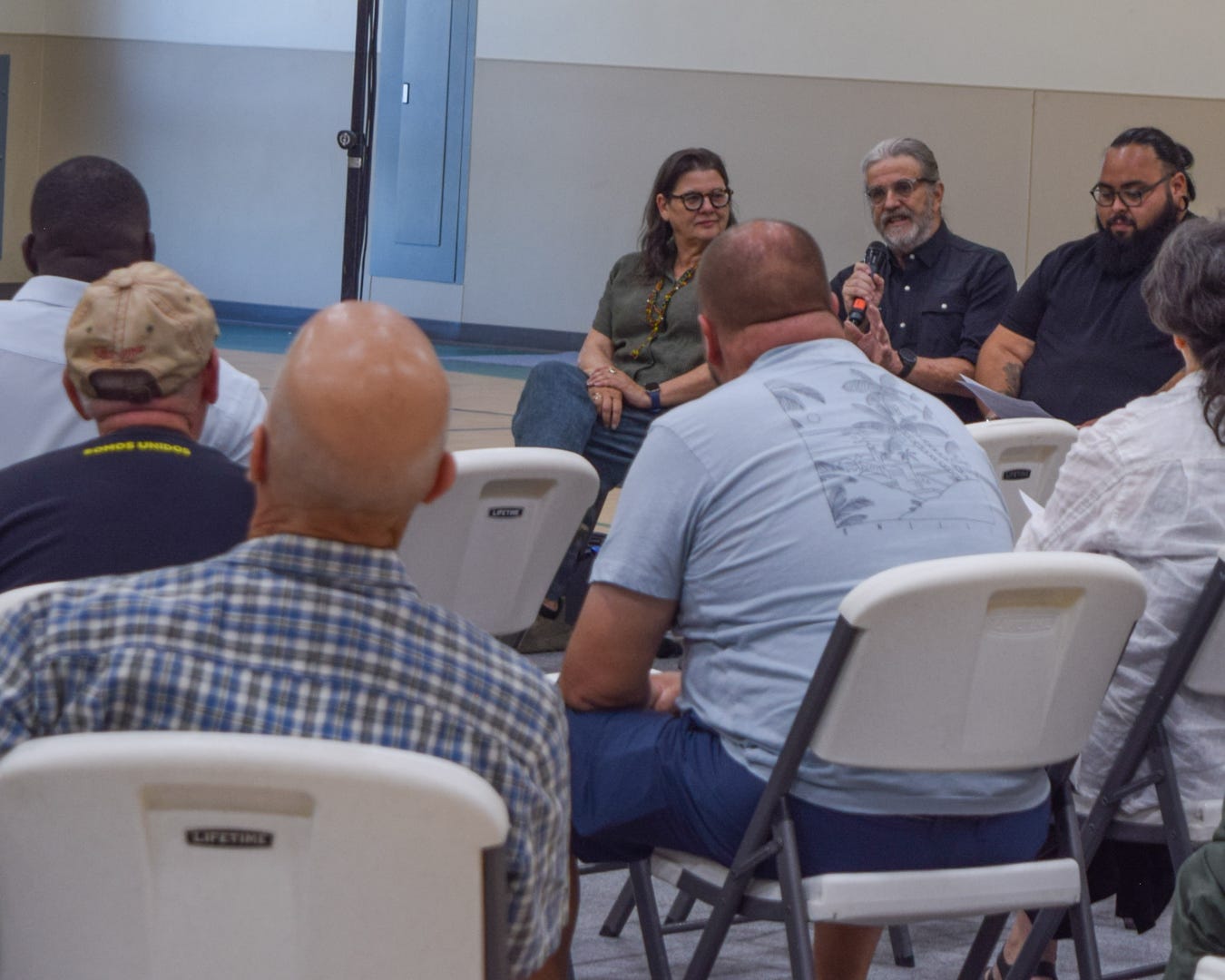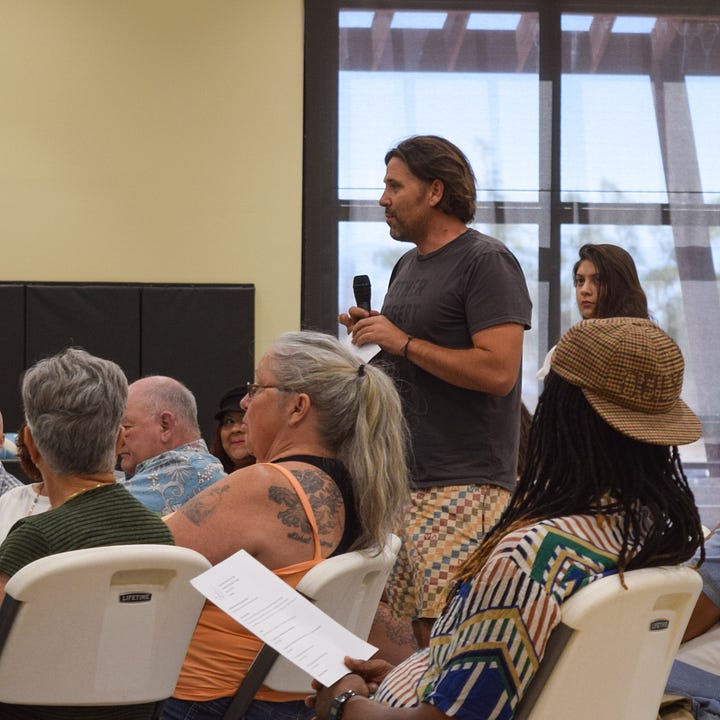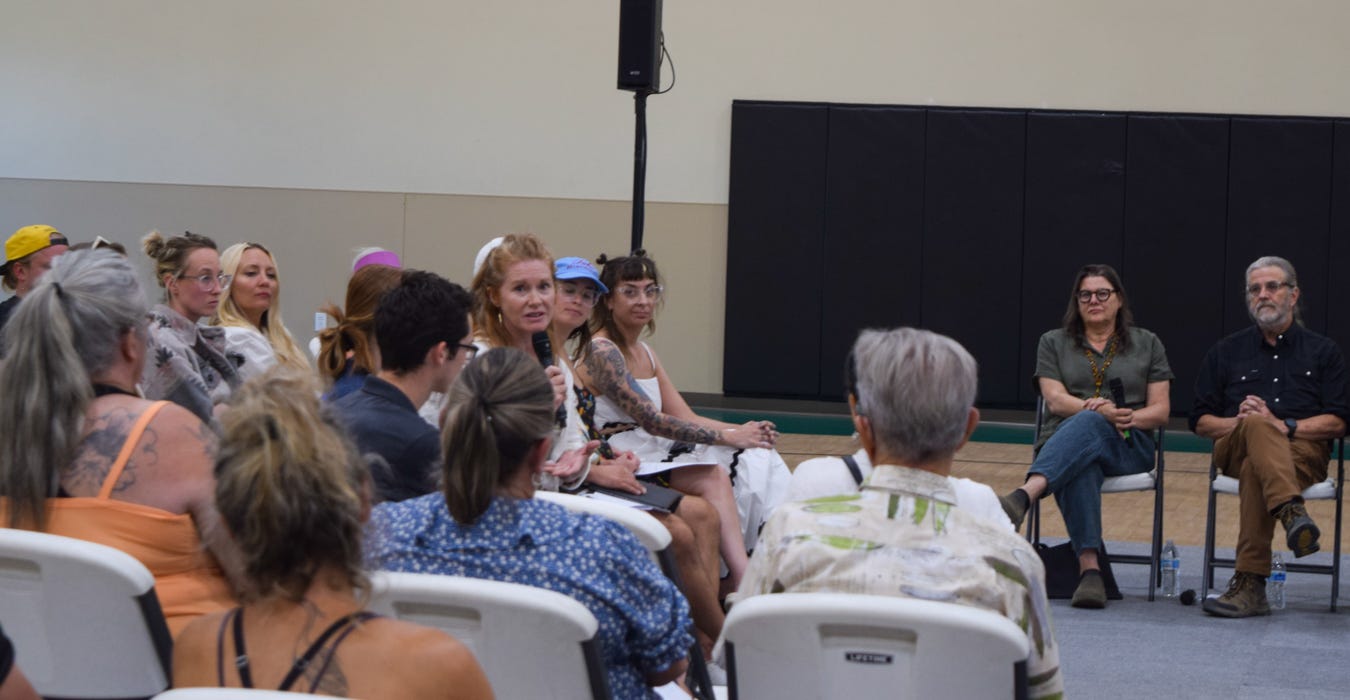Creating an Affordable and Sustainable City: 29 Palms Town Hall, Part 1 of 3
Desert advocate Chris Clarke suggests Twentynine Palms has an opportunity to harness the talent and energy of its residents and visitors

Note: This is the first of three articles in which Desert Trumpet writers recap the discussions held on Saturday, June 29, during Envisioning Our City’s Future: A Twentynine Palms Town Hall, hosted by the Desert Trumpet. On Saturday, June 29, more than 50 residents attended the town hall held at the community center in Freedom Plaza. The town hall was hosted by the Desert Trumpet and supported by the Desert Trail. The open discussion among residents was facilitated by moderator and Desert Trumpet Editor-in-Chief Cindy Bernard and prompted by our guests: Chris Clarke, Host, 90 Miles from Needles, the Desert Protection Podcast, Paul Razo, Business owner, Member, Public Art Advisory Committee (PAAC) and Carrie Williams, Co-owner, Jeanine Beauty Supply, CEO Women of Color Global 29.
Wide-ranging conversations between the panelists and the audience included issues of concern to Twentynine Palms, such as education and opportunities for young people, housing, balancing tourism and livable conditions for residents, and support for local businesses. It was a lively get-together, and we are grateful to everyone who took part.
Moderator and Desert Trumpet Editor-in-Chief Cindy Bernard led off the Town Hall by reading the guiding principles of the City’s General Plan, written in 2012:
Promote a high quality of life while preserving the city’s desert and small town feel;
Encourage high quality development compatible with the Joshua Tree National Park, the Marine Corps Air Ground Combat Center, and the city's desert small town character;
Develop a strong and diversified local economy with a focus on arts, culture, tourism, retail job growth, and the overall quality of life for all community members;
Preserve the desert environment, its natural and cultural resources for future generations; and
Promote sustainable and adaptable growth principles in the development of the city.
These principles were a touchstone for conversation throughout the afternoon. Chris Clarke, a Twentynine Palms resident and the host of 90 Miles from Needles: The Desert Protection podcast, kicked off the discussion by saying, “one of the reasons that I like living here as much as I do…is that this is a diverse place. It's diverse in a way that people don't usually think about when they talk about diversity.”
This idea of diversity showed up again and again in conversations throughout the Town Hall – that Twentynine Palms is diverse in income, ethnicity, and in age in ways that perhaps aren’t true in the rest of the Morongo Basin or southern California.
Even if, Clarke said, residents disagreed with him, “they were kind. And they were straightforward. And I just really valued that. And that's the kind of place that 29 is, to me. There's no subterfuge, there's no pretension. We are what we are, and I love that.”

What does “sustainable” mean to Clarke? “I take it to mean being able to go through life without eating the seed corn; without leaving things worse for your kids and your grandkids.”
He sees the community as an ecosystem, with human resources flowing in, including Marines – some with families – many of whom are in Twentynine Palms for a short time. Visitors who come for two or three days are part of the 29 ecosystem – they come in for two or three days and expect to have a good time. This can be destructive, raising the price of housing to the point where people can’t afford to live here because Airbnbs are eating up available residences.
“But it can also be a way in which we get new people to come in and want to do good by this place,” Clarke said. “We can have people coming in and falling in love with the desert, even if they don't know much about it at first.” Clarke struck an optimistic note, “ I just think that there are potentially really creative ways to harness that resource, to harness the energy, and materials and thoughts, and new pairs of eyeballs that are coming into this area every day. And I think that in there somewhere is the key to having this place be economically viable, and thus affordable for people who want to live here. Or people who don't want to live here, but are being made to by the Department of Defense (laughter).”


Hotelier and Tourism Business Improvement District (TBID) Board Member Ashton Ramsey suggested that there should be a design review for housing, that local architecture could be more interesting and varied. City Councilmember Octavious Scott followed Ramsey’s remarks by saying he is advocating for a revised General Plan that would look at zoning “so we can start looking at these ideas of how do we develop our neighborhoods in a sustainable way. We might want to look at our zoning laws,” he said, “when we do our general plan review because maybe there's some other areas of the city that could benefit from other types of housing as well.”
Conversation shifted to exceptions to existing zoning, and Cindy Bernard noted that the Planning Commission makes exceptions to the General Plan. “One of the challenges we've had writing about the Planning Commission in the Desert Trumpet, is that we have a downtown plan. But very often, we have a Planning Commission, I believe, that plays a little bit loose and fast with our plan. And so for instance, Veno brought up at a recent meeting, that Starbucks was put in without the required landscaping buffers that it should have had, because they really wanted the Starbucks and the city was fearful that if they put requirements on them, that the Starbucks might go away.”
Clarke brought the discussion back around to having open conversations. “You have people that firmly believe that we need to be building twelve-story hotels in downtown and you have people that firmly believe that we need to be preserving the rural character of 29 as much as possible.” People who have a stake in the City’s character need to show up, “even if it's exasperating. Because that's what a lot of local politics is, is just showing up, talking to the same people and getting exasperated and then eventually figuring out where you want to go.”

Rhonda Coleman of Groundwork Arts said she was attracted to Twentynine Palms by the number of creative people who live here, “it's one of the highest concentrations of creatives I've ever come across, either on the West Coast or East Coast.” She expressed concern that it’s no longer an affordable place to live and won’t attract artists, musicians, dancers, and writers.
Coleman was also worried that it’s not possible to entice teachers to live and work here, and education suffers. “But how do you encourage a teacher who already works a gazillion hours and makes a very small amount of money?”
She observed that when she arrived 17 years ago, people weren’t always welcoming to newcomers – and she sees that changing, that there’s more of a dialogue between people who grew up here and recent arrivals.
Kimberly Zzyzx of the Institute of Inquiry echoed the need to make 29 a more attractive place for educators and brought up the lack of affordable childcare. She brought up San Bernardino’s First Five – a state-funded organization that promotes, supports, and improves the early development of children. Their 2023 strategic plan reports that only 6.2% of families have access to affordable childcare.
“And when we're thinking about the whole ecosystem,” Zzyzx said, “What would it look like to have a partnership between the city and between some of these organizations raising money towards those goals? What would it look like to have collectives that meet periodically to identify what sort of state funding there could be? What about hosting some of the events like we do for July 4, or whatever else up to benefit a cause?”
Stay tuned for parts 2 and 3, in which young people speak up and pleas are made for development to be more mindful of the environment—among many other fascinating topics!
Want more? Read the complete transcript of Part One: Creating An Affordable and Sustainable City
Feel free to share this article.
Leave us your thoughts in the comments below. Please note that we do not allow anonymous comments. Please be sure your first and last name is on your profile prior to commenting. Anonymous comments will be deleted.
Many communities in the Morongo Basin are economically disadvantaged, so our coverage will always be free. However, if you have the means to support our work, we always appreciate upgrades to a paid subscription. Your upgrade helps keep subscriptions free for those who cannot afford to donate.
Note that donations in excess of $100 are tax deductible to the extent allowed by law, and your subscription/donation will be listed as AHA Projects, the name of our fiscal receiver, on your statement. Donations over $100 can be made via the Aha Paypal.

